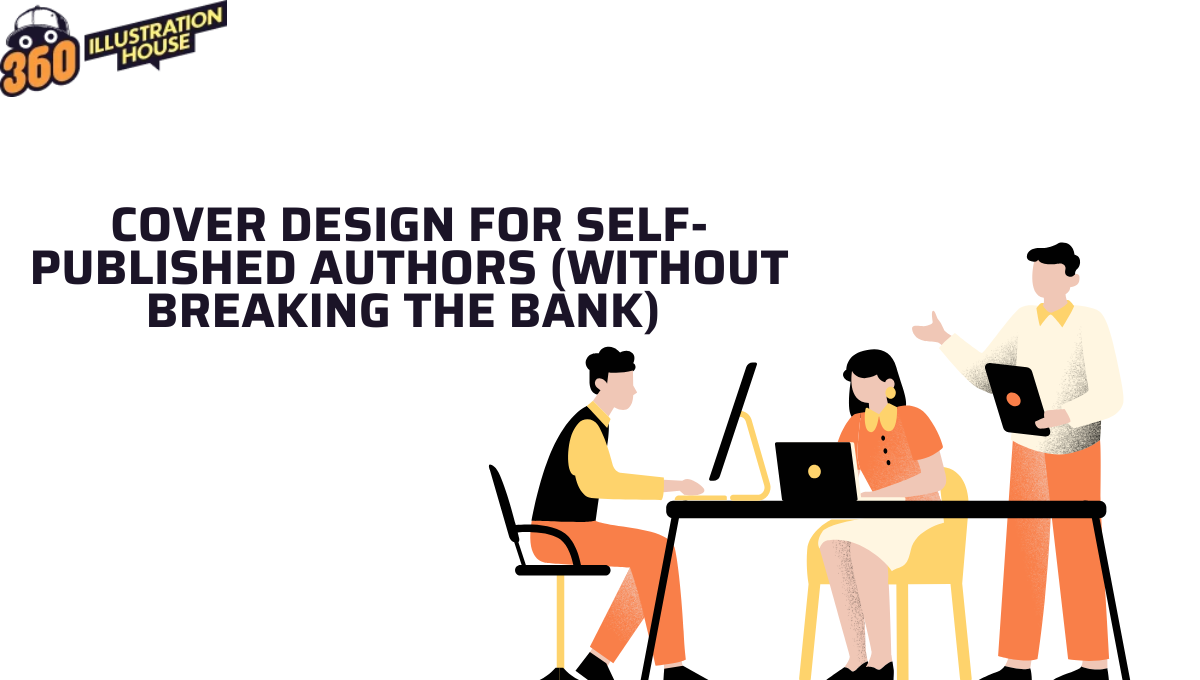Cover Design for Self-Published Authors (Without Breaking the Bank)
The cover is the first thing people see when they look at your book, whether it’s on a shelf or...

The cover is the first thing people see when they look at your book, whether it’s on a shelf or on a screen. It’s the first impression, the first hook, the first invitation. It’s the face of your book, and you want it to be a beautiful one. ~ Derek Murphy
For traditionally published authors, the book cover is handled by an in-house publishing company. But when it comes to self-published authors, the heavy duty of making the best cover design falls on their shoulders.
If you, even for a second, think, “Huh, I can just have a plain black cover just like in old times. People bought those books – they will surely buy mine too.” Yeah, well, hold onto that thought, because in a 2023 survey, almost 60% of Americans (57%) said they have bought or read a book just because they liked its cover.
So now that it’s clear that you NEED to put efforts into the book cover, but here is the real question
How am I supposed to do it without breaking my bank?
Don’t worry! We are here to help you. Today, we are going to discuss the different ways to create professional, genre-accurate, and high-converting covers without spending a fortune.
Key Takeaways
- Your book cover design is your biggest marketing tool, but you don’t need to spend a fortune to look professional.
- Learn how visibility and book cover design are interconnected. Apart from attracting an audience, a cover can also improve your book’s visibility.
- When it comes to saving money on cover design, explore how pre-made templates, free resources, freelancers, and top-rated custom book cover services can help you
Why Cover Design Matters?
Well, I can tell you that the right cover attracts the right audience, or it gets shared a lot, but these are things you’d already know, right?
As a self-published author, you should be aware of only one important term: Visibility.
So quickly, in case you don’t know, visibility refers to the extent to which a book is noticed and accessible to potential readers.
Many writers forget an important thing: the design of your book cover affects how visible it is. This is especially true online, where people can find things in just a fraction of a second.
Platforms like Amazon and Barnes & Noble rely heavily on search algorithms and visual queues. While metadata and keywords help place your book in search results, it’s the cover design that determines whether someone clicks.
A clean, genre-accurate, well-composed cover increases your click-through rate (CTR), which automatically tells the algorithm, “This book is interesting.”
So, you can understand that once this is done, your book will get more impressions, recommendations, and chances to be seen.
How to Get a Stunning Cover Design Without Breaking the Bank
Many self-published authors assume that a high-quality cover design will cost thousands of dollars. But you’ll be surprised to know that with tools available online and multiple affordable custom book cover design services out there, you can get a professional cover without spending too much.
1. Use Pre-Made Templates
There are many easy-to-use platforms, such as Canva, BookBrush, and Adobe Express, offering pre-made templates tailored for books. These tools allow you to drag and drop your images, adjust fonts, and experiment with colors—even if you have zero design experience.
- Pros: Cheap or free, easy to learn, quick turnaround.
- Cons: Limited customization, may not look fully unique.
Using these tools, you can get a high-quality cover that looks polished without needing advanced graphic design skills.
2. Use Free Resources
You don’t need to pay for fancy illustrations or photos to make your cover stand out. The internet is full of royalty-free and commercial-use resources—if you know where to look.
For Images:
- Unsplash: Artistic, high-resolution photos.
- Pixabay: Free illustrations, vectors, and photos.
- Pexels: Good for lifestyle and abstract shots.
- Shutterstock: Paid, but affordable bundles with more polished options.
Always check the license—you want “free for commercial use, no attribution required” where possible.
3. Typography Should Not Be Ignored
Typography can make or break your book’s first impression. And you don’t need to pay for expensive fonts to get it right.
Where to Get Quality Fonts:
- Google Fonts: Modern, professional, and free.
- Font Squirrel: Hand-picked, commercial-use fonts.
- Creative Market: Premium fonts are often on sale.
Quick Tips:
To make a professional custom book cover design, follow these tips:
- Make sure your title is legible and in thumbnail size.
- Choose fonts that match your genre vibe (elegant serif for romance, bold sans-serif for thriller, etc)
- Don’t go overboard—two fonts max is a good rule.
4. Hire Freelancers on Marketplaces
If you want something more personalized but still affordable, consider hiring a freelance designer on sites like Fiverr, Upwork, or 99designs. You can find talented designers offering custom book cover artwork services at competitive rates, sometimes starting under $100.
How to Choose the Right Freelancer
Sure, coming across tons of freelancers with one search can leave you overwhelmed. So to ensure that you end up professional, you must check:
- Check the designer’s portfolio for covers in your genre—what works for fantasy won’t work for self-help. Genre consistency is key.
- Ask if they’ll handle technical specs like spine width, bleed, barcode placement, and KDP size requirements.
- Start with a small test cover or concept sketch if you’re unsure about the designer—this lets you gauge their style without committing too much upfront.
- Zoom in on cover samples and test how the title and author name look in thumbnail size—if you can’t read them, neither can your readers on Amazon.
5. Look For Top-Rated Custom Book Cover Services
There are companies that create custom book covers specifically for self-published authors. Some of these companies offer different package options at various prices, which can include cover design, illustrations, formatting, and marketing materials.
Final Thoughts
Getting a beautiful cover design doesn’t have to drain your wallet. By exploring options like DIY tools, freelance designers, and specialized services, you can find a way to present your book professionally and attractively. Remember, your cover is your book’s first impression, so you’d better invest wisely in it.
FAQs
What are emotional cues in cover design?
Colors, fonts, and images trigger feelings. For example, red = urgency or love, serif fonts = tradition, and soft lighting = warmth.
How can I make sure my cover works at thumbnail size?
Resize your design to 160 pixels wide, as it looks on Amazon. At this size, the title should be clear and the image should stand out. If it looks blurry or messy, make the design simpler and use bolder fonts.
My book is serious, but should the cover design still be colorful to stand out?
Not always. A cover should match the tone, not just grab attention. A muted palette can still be striking if it’s emotionally aligned.
Can I use AI-generated art for my book cover?
Yes, but check licensing. Some platforms restrict commercial use. Also, readers can spot low-quality AI. So, it is better to use it with care.
Should the cover design reflect a key scene from the book?
Not always. The cover and its design are made to sell the vibe, not the plot. Focus on mood, genre, and what makes a reader feel curious or connected.
Can too much detail ruin a cover?
Yes. Too many elements confuse the eye. A strong cover usually has one focal point and a clear visual hierarchy.


